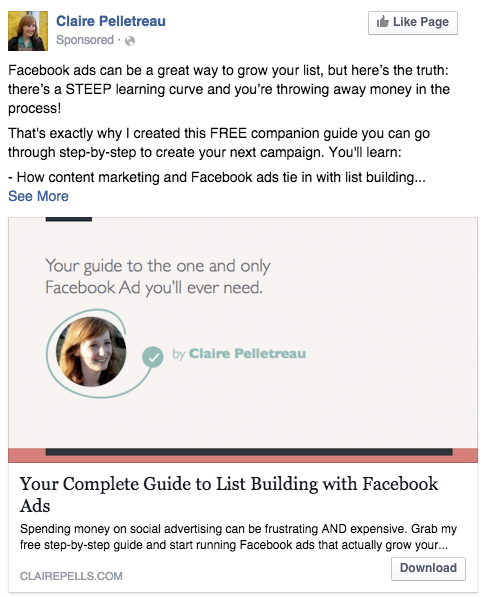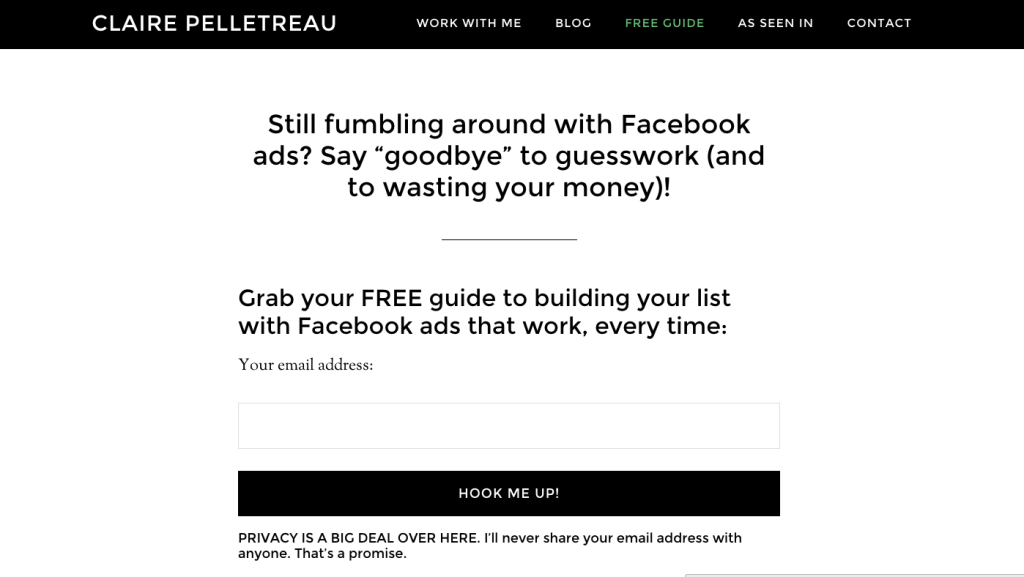I spend a lot of time looking at landing pages. Because I focus my teaching on using Facebook ads for list building, your landing page automatically becomes a big part of the growing-your-list equation.
I’m actually starting to think that your landing page is MORE important than the ad itself. But I’ll talk more about that on another day.
Today I want to share with you this little experiment I did last year. I was curious to see what would happen if I ran ads that pointed people to a LeadBox, one of Leadpages’ features, instead of sending people to a landing page.
Why wouldn’t you want to direct people to a custom landing page?
Typically your landing page has one and only one purpose: to get me to take a specific action. In terms of pages designed for list building, that action is to give you my email address.
But there are three reasons why you might want to consider this skip-the-landing-page technique:
- Your website theme doesn’t have a landing page option. Because of the default design of your website, your navigation bar(s) and beautiful sidebar end up acting as distractions on your landing page. So even if your offer is amazing and you’ve got the copywriting chops to prove it, the money you spend sending people to that page might be wasted. They could forget to opt in because they’re clicking over to your blog, your about page, or your “As Seen In” page. Your free content is forgotten and those visitors don’t end up on your list.
- Putting together a landing page is time consuming. You gotta write the copy, figure out the design, add in the optin form. Even with software like Leadpages or OptimizePress that are designed to make things simple, it can take lots and lots of time to customize everything.
- Despite all your work, your landing page still isn’t converting. You’ve tweaked and rewritten and are still getting traffic, but you can’t quite break that 30% conversion rate. (30% from cold traffic is the absolute minimum conversion rate that I’ll accept for my clients, but I’m always aiming for a lot closer to 50% or 60%.)
How I tested ads without a landing page:
Using my typical target audience inside a simple ad set, I created this ad:
The ad drove traffic to my standard landing page at that time. Since then I’ve opted for one of Leadpages’ templates, but this one always converted at 40% or more:
Then I duplicated the ad, creating an exact replica. This time I changed the url attached to my new ad. I used the url Leadpages gave me when I created this LeadBox so that clicking on this second ad would cause this box to pop up on your screen:
Then I ran these nearly-identical ads at the same time. Putting them both in the same ad set automatically A/B tested my landing page versus my LeadBox.
Here’s how that works: when you run two or more ads simultaneously in the same ad set, Facebook starts out by running them both, showing them more or less equally to your target audience. So one person might see the ad that points people to my landing page while the other sees the ad that triggers my LeadBox to pop up. There is zero discernible difference between the two ads, so the people viewing them can’t tell what will happen when they click.
But once Facebook starts to see that one ad is getting better results than the other (like a higher CTR or a cheaper cost-per-conversion), they automatically stop showing the ad that isn’t performing as well.
This is why you will often see that one of your ads got a lot more Reach than the other(s). Facebook is optimizing your campaign for you. (I love this feature, and it’s also the reason I won’t run more than two ads at once.)
So what happened?
My ads were shown and people clicked on both, but the early conversions came in cheaper from people who clicked on the LeadBox ad! So almost immediately Facebook declared my Leadbox ad the winner in this test and stopped showing the ad connected to my landing page. You can see the final results for this campaign that I spent $140 on:
NOTE: I plan to run this test again. One conversion from the landing page ad isn’t enough data to make a completely confident call on this, but I can definitely say that this LeadBox performed as well if not better than my landing page.
So…do you need a landing page to run ads?
Not necessarily. You may be able to capture leads with a simple Leadbox like the one I created. Notice, however, that my LeadBox features very similar copy on it as what was on my landing page. It also features an image of the guide you get when you opt in. And that guide image matches the image on the ad, so there’s consistency throughout the entire Facebook-ad-to-LeadBox user experience.
How much do I have to pay to use LeadBoxes?
The most basic Leadpages plan comes with LeadBoxes, which will set you back $37 per month or $300 if you pay upfront for that plan for an entire year.
(FULL DISCLOSURE: I use the Pro plan and paid annually to save a bunch of money, but I started off paying for the Pro plan month-to-month to see if I really needed it. I went for the Pro plan mostly because I wanted the A/B testing feature, but access to their affiliate program is a nice plus as well. The links to Leadpages in this post are my affiliate links, but I would definitely recommend this LeadBox feature even if I didn’t receive a dime from them!)
What about you? What are you thinking about testing in your business?
Tests don’t necessarily have to involve A/B testing or Facebook ads (but they ARE a great way to get a quick boost of traffic to a page!). I consider pretty much everything I do in my business a kind of test, from a special offer to a launch format, even my products and services! It certainly helps to view it this way when things don’t go as you’d hope. These kinds of tests help you learn something about what you’re good at, what your audience really needs, and how you can put that all together to best serve them.
So that thing you’ve been toying around with in your mind, something you’re not sure if you can commit to but you’d like to test out? Drop it in the comments below!















I’ll kick off this thread myself! I’m all geared up to try out…podcasting! What about you?
Same. Have you seen http://www.podcastprodigy.com ? I am not affiliated with Rachel at all but bought the program crazy cheap a couple weeks ago and it is suuuuch a great resource for podcasting. Good luck with yours!
By the way, how do you explain fb determining a winning ad before the data is statistically significant? I always create a separate ad group for each ad so they get equal exposure until there is enough data for a significant result. It’s a pia but it just seems awfully premature for facebook to have cut off one of your ads after only 88 impressions…. Thoughts? Thanks! Wendy
You’re totally right – it can be really annoying how they “call” the winner way too soon. But when you run two ad sets at the same time to the same audience, you’re almost definitely exposing people to both without knowing exactly how many times a person sees each ad. I prefer to let Facebook call the winner and keep optimizing that one ad so that it gets shown on in the best placement, to the best age group, etc. It’s not perfect but I noticed that having too many variables (like different ad sets) doesn’t give me clear data to work with.
And thanks for the resource, Wendy! I’m definitely going to check it out!
Hmmm, good point, didn’t think about multiple impressions per person… I would love to hear about results testing FB’s chosen winner versus the statistically significant winner. I can’t believe there isn’t more on the web about that trade off or how/why they choose the winning ad so fast…
Good luck with the podcast, thanks for the response!
Curious–why do you need the A/B testing in LeadPages if Facebook is already doing a split for you?
Great question – I definitely should have been clearer about this in the post.
So Facebook A/B tests my ads, and in the case of this test, my landing page versus Leadbox. But if I want to drive people to a landing page, Leadpages allows me to easily set up two similar landing pages and then splits the traffic to them. So I could test the name of my product, the call to action, the copy, colors, etc using Leadpages. Does that make sense?
“Test everything!”
Thanks for sharing- I need to do this myself (haven’t started)! I always thought it was a MUST to have a landing page to get the best conversions, but its interesting not everyone needs one
You’re welcome! I’d really love to hear how it goes if you try this out too!
Hey Claire, I’m totally trying this LeadBox thing on your suggestion – just finished my ad. I’ve had great results w/ LeadBoxes in guest posts – so why NOT in ads? I love this idea, but I do have a question: Were you able to get it so the LeadBox pops up right over Facebook, or does it open in a new window? I’ve found that when you grab the LeadBox URL by itself (as opposed to all the html code), it opens up a new window with a grey background. Anyway, can’t wait to see if this works!
You know I actually have no idea whether or not it opened that LeadBox on the same page or in a different window. I kinda assumed that it was on the same page since so many people opted in.
Let me know how it works for you, Jess!
As far as I can tell, facebook will not allow your leadbox to appear “over” facebook, the way leadboxes work on most sites. Instead, it opens a new tab with just your leadbox in the center of the screen, which is basically the same as having it link to a leadPage. This begs the question: what makes the leadbox perform better? Because the way this works is exactly like having it lead to a leadpage. Is it the simple and minimalist look of the leadbox (again, opened on a new tab) vs the complex look of a leadpage (also opened on a new tab)? Please let me know if you’ve done any more testing along this line.
You’re right, Steven, the leadbox does open in another tab. I haven’t tested this since, although this is a good reminder and I’ll test it when I turn ads on again soon.
Have you tried it out yourself?
Not yet but we’re launching a campaign in about 5 days and I might work that into it just to see what the difference is.
My suspicion is that, if the leadbox in a new tab performs better, it’ll be because of the minimalist appearance and continuity of thought. I think a lot of people who click a button that they think will get them something (info, updates, products, etc) they simply want “that thing” when they click.
If the click is followed by a whole new web page (like a typical lead page) with images and text or even just one big image and an optin box, something in the back of their head tells them there’s a rupture between what they started out to do and where they are and often that though, conscious or not, leads to annoyance and a decision not to pursue the same tack.
Whereas a little box with no new background (it looks like in the new tab it’s just a grey/empty background) and a minimalist look to it keeps them on that same mental track that they embarked on with the initial click.
It’ll be interesting to see how it plays out.
Hi, Claire,
Side track question. How do I avoid being banned by fb for using squeeze page? They are unpredictable, as for the same ad being approved and running for sometimes, and after changing the target interest group, my ads were disapproved and also my ad manager is blocked by fb. Did you have such experience with fb? Thanks.
Hi Eric, so sorry to hear that happened. I’ve only heard of this happening a couple times but I found this about landing pages and FB ads: http://veronicapullen.co.uk/2015/02/9-steps-to-facebook-compliant-squeeze-pages-in-2015/
I’m working on a post about getting ads approved, keep an eye out for it! In the meantime, try creating an account with business.facebook.com – I ended up with 2 advertising accounts when I created my account there, so maybe that’s an option (but full disclosure, I can’t confirm that you’ll get another account that way, it was just my experience).
Really crazy question – why lead box vs Aweber pop up ? I use a hover form (Aweber) and trying to find out why the lead box (other than double opt in, as I can do this with Aweber) is better performing?
At the time of this experiment I used Mailchimp which didn’t have any kind of pop-up feature like Leadboxes. (Now I used ConvertKit.) But now Facebook has its own feature similar to this, you can read more about it here: clairepells.com/leadads
Are you going to be writing up a post on ConvertKit ?
Would love to hear your thoughts on them so far…
Isaiah
Hey Isaiah, I included it in this tools/coaches roundup here: https://clairepells.com/business-tools-and-coaches. Let me know if you have any specific questions about it!
Thanks for sharing this tutorial/test Claire! I’ve been using LeadBoxes with GREAT success for quite some time on my blog and other sites. Most recently – I’m using one that gives away a coupon code for something on one of my niche sites and I wanted to see if I could run an ad on FB to make that same LeadBox open up in FB. I googled the topic and found this post! Thanks again – heading over to insert my Leadbox in an ad right now!
Very nice blog, btw. I could almost tell you were on Genesis before I even looked at the footer! Your site looks great!
Hey Matthew, thanks for visiting! Unfortunately the box doesn’t pop up on FB itself, it opens a new tab. However I’m still a fan of this!
Another thing to look at is FB’s Lead Generation ads, which operates in a similar way: clairepells.com/leadads